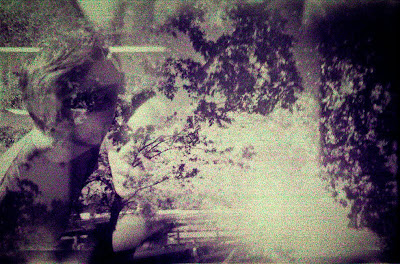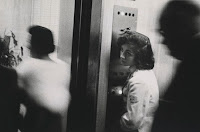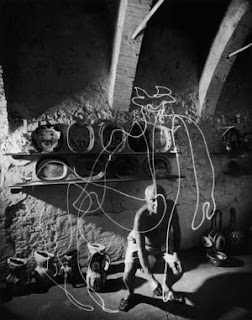Tuesday, November 30, 2010
Wednesday, November 24, 2010
12s XPro Chrome with Black and White Chemistry
Grade 12s,
Here are some examples of xpro chrome in black and white chemistry. My friend Jen did all this using a Kodak developer HC-110, working solution B, but you can also use our TMax developer. Don't forget to overdevelop your film. However, since I have not done any tests using this particular process, I cannot advise you on development times. I would suggest 2-4 minutes extra though. You will need to experiment to see.
You can also tone your film afterwards using the Berg film and paper toner. There are several colours to choose from: blue, yellow, brown, sepia, etc. This will basically make your prints into a monochromatic print in the colour that you have toned to. Another thing to think about when you are 'wrecking' your film.
Have fun and I look forward to seeing all your results!
Tempus fugit.

Here are some examples of xpro chrome in black and white chemistry. My friend Jen did all this using a Kodak developer HC-110, working solution B, but you can also use our TMax developer. Don't forget to overdevelop your film. However, since I have not done any tests using this particular process, I cannot advise you on development times. I would suggest 2-4 minutes extra though. You will need to experiment to see.
You can also tone your film afterwards using the Berg film and paper toner. There are several colours to choose from: blue, yellow, brown, sepia, etc. This will basically make your prints into a monochromatic print in the colour that you have toned to. Another thing to think about when you are 'wrecking' your film.
Have fun and I look forward to seeing all your results!
Tempus fugit.

Friday, November 19, 2010
11s Night Photography- Painting with Light
Painting with Light
Painting with Light- Flashlight, Tripod, Camera- Manual, Shutter Speed set to “B” setting. Draw with light. Aperture approx f5.6.
Multiple Exposure 1- Flash, Tripod, Camera- Manual. Shutter Speed B Setting Flash. Flash subject and then have subject move and flash them again repeat as long as you want… Aperture- f 11 or higher.
Multiple Exposure 2 with Painting with Light- Flash, Tripod, Flash Light, Camera- Manual. Shutter Speed B Setting Flash. Flash subject and then have subject move and flash them again repeat as long as you want… Aperture- f 11 or higher.
Slow Blur- Tripod, Camera- Manual. Shutter Speed B Setting Have subject move slowly through the frame with a low light pointed towards them… Aperture- f 11 or higher.
Slow Blur with Freeze Frame- Tripod, Camera- Manual. Shutter Speed B Setting Have subject move slowly through the frame with a low light pointed towards them, but this time, stop partway through the frame and then continue… Aperture- f 11 or higher.
Experiment- try something not on this list…
Shutter Speeds
Still photo with street light- Camera, tripod/steady low shutter speed, low aperture, higher ISO
Still Photo of Street Light with Star effect (f-16 or higher)- Camera, tripod/steady even lower shutter speed, high aperture, higher ISO.
Moving lights, camera still- Camera, tripod/steady low shutter speed, low aperture, higher ISO
Moving camera with lights- Camera low shutter speed, low aperture, higher ISO
Experiment- ???
Assignment
Print a contact sheet- label effects, make sure the exposures are not too dark or light. Try to get them all.
Put images 2+ in Journal and on Ning site.
Painting with Light- Flashlight, Tripod, Camera- Manual, Shutter Speed set to “B” setting. Draw with light. Aperture approx f5.6.
Multiple Exposure 1- Flash, Tripod, Camera- Manual. Shutter Speed B Setting Flash. Flash subject and then have subject move and flash them again repeat as long as you want… Aperture- f 11 or higher.
Multiple Exposure 2 with Painting with Light- Flash, Tripod, Flash Light, Camera- Manual. Shutter Speed B Setting Flash. Flash subject and then have subject move and flash them again repeat as long as you want… Aperture- f 11 or higher.
Slow Blur- Tripod, Camera- Manual. Shutter Speed B Setting Have subject move slowly through the frame with a low light pointed towards them… Aperture- f 11 or higher.
Slow Blur with Freeze Frame- Tripod, Camera- Manual. Shutter Speed B Setting Have subject move slowly through the frame with a low light pointed towards them, but this time, stop partway through the frame and then continue… Aperture- f 11 or higher.
Experiment- try something not on this list…
Shutter Speeds
Still photo with street light- Camera, tripod/steady low shutter speed, low aperture, higher ISO
Still Photo of Street Light with Star effect (f-16 or higher)- Camera, tripod/steady even lower shutter speed, high aperture, higher ISO.
Moving lights, camera still- Camera, tripod/steady low shutter speed, low aperture, higher ISO
Moving camera with lights- Camera low shutter speed, low aperture, higher ISO
Experiment- ???
Assignment
Print a contact sheet- label effects, make sure the exposures are not too dark or light. Try to get them all.
Put images 2+ in Journal and on Ning site.
Thursday, November 18, 2010
Contemporary/Dead Photographer
Select-Research-Write-(Email12s only)-Share-Photograph
Criteria- Grade 11 Dead Photographer Assignment
- Select a photographer who is currently living (12s) or dead (11s) and working in the medium. Find a photographer who you are interested in. This is likely the most challenging and important of the steps; find a photographer that inspires you.
- Research several using the internet. Find your top 5 five favourite. Write 5 important points about each and put in your journal with an image for each and narrow it down to one.
- Write an article about the photographer's life, the medium, photostyle and offer an opinion reflection and commentary of their work in 350 to 500 words. Include a bibliography.
- Email (12s only) your photographer, let them know that you are interested in their work and you are doing a project for school based on their work. Ask them for some information. Print out your email to them and their response.
- Share your contemporary photographer with the class any way you want. You are to articulate information from your article to the class verbally, and visually.
- Photograph in their style, create a contact sheet and five 5 x 7 prints and one 8 x 10 print.
When you find your photographer, make sure there is some information on them even a resume can be helpful, but it will help to get more. And you will need to find at least five photos of their style.
If that doesn't work for you,
Photography Now- visual list of contemporary photographers.
Yahoo Photo Masters- index of photographers
Museum of Contemporary Photography- look up collections and also browse by artist. (I love Colleen Plumb.)
Magnum Photo
International Center of Photography
CAPIC -The Canadian Association of Professional Image Creators
PPOC- Professional Photographers of Canada
Lisa Pritchard Agency
Women in Photography
Wednesday, November 17, 2010
11s Shutter- Painting with Light
The Shutter
The shutter is like a door, it opens and closes to let light into the camera to expose the film, or sensor to light for a set time. Shutter speed is measured in seconds – or in most cases fractions of seconds. The bigger the denominator the faster the speed (ie 1/1000 is much faster than 1/30).
Shutter Speeds:
1 2 4 8 15 30 60 125 250 500 1000 2000 4000
The lower the number, the slower the shutter speed, the greater amount of light and blur.
The higher the number, the faster the shutter speed, lesser amount of light and blur.
B-Bulb: When you press the Shutter, it opens for as long as you keep your finger on the shutter button
T-Time: When you press the Shutter button, it stay open until you press it again (not common on newer cameras).
Guess what shutter speed was used for the following photos:
 by Dan Barham
by Dan Barham
Watch the following:
Willowz Jubilee
Painting with Light
Cool Light
Stupid Gratuitous Violence, but Cool
Define the following , explain the function of the setting, add in your journal:
The shutter is like a door, it opens and closes to let light into the camera to expose the film, or sensor to light for a set time. Shutter speed is measured in seconds – or in most cases fractions of seconds. The bigger the denominator the faster the speed (ie 1/1000 is much faster than 1/30).
Shutter Speeds:
1 2 4 8 15 30 60 125 250 500 1000 2000 4000
The lower the number, the slower the shutter speed, the greater amount of light and blur.
The higher the number, the faster the shutter speed, lesser amount of light and blur.
B-Bulb: When you press the Shutter, it opens for as long as you keep your finger on the shutter button
T-Time: When you press the Shutter button, it stay open until you press it again (not common on newer cameras).
Guess what shutter speed was used for the following photos:
 by Dan Barham
by Dan BarhamPainting with Light
Watch the following:
Willowz Jubilee
Painting with Light
Cool Light
Stupid Gratuitous Violence, but Cool
Define the following , explain the function of the setting, add in your journal:
- SLR-
- TLR-
- Shutter-
- Shutter Speeds-
- Bulb-
- Cable Release-
- Tripod-
- Light Meter-
- Bracketing-
- Hot Shoe-
- Slow Shutter Speed
- Fast Shutter Speed
- Panning
- Painting with Light
- Multiple Exposures
Tuesday, November 16, 2010
History of Photography
History of Photo Assignment
1. Find 3-5 photo examples
2. Dates
3. Photographer, People involved
4. Historic Significance, explain historic relevance in the context of Photography
5. Other historic events at that time
1. Find 3-5 photo examples
2. Dates
3. Photographer, People involved
4. Historic Significance, explain historic relevance in the context of Photography
5. Other historic events at that time
Tuesday, November 9, 2010
Photo 12- String Theory- Principles of Design
Balance, Contrast, Emphasis, Harmony & Unity, Movement, Pattern, Repetition, Rhythm
Project Criteria
Project Criteria
Photo 11- Old Camera Composition Project
Photographic Emphasis Techniques
Define the following and find examples for your journal:
Leading Lines-
Repetition-
Rule of Thirds-
Contrast-
Framing-
Then take an old camera and photograph it. Create compositions using the above techniques to emphasize. See link for project details
Define the following and find examples for your journal:
Leading Lines-
Repetition-
Rule of Thirds-
Contrast-
Framing-
Then take an old camera and photograph it. Create compositions using the above techniques to emphasize. See link for project details
 |
| Rule of Thirds |
 |
| Contrast |
 |
| Repetition |
 |
| Framing |
 |
| Leading Lines |
Friday, November 5, 2010
Creative MX Day Critique
Reflect on your Creative Mix Day
- How was Creative MIX?
- Best experience of the day,
- Least favourite experience of the day,
- Best photo moment,
- Select one image from the Vancouver Art Gallery Exhibition put the image in your journal and comment on the photo- how it it effect you?
- Comment on the Anonymous Photography Collaboration Project- what did you enjoy the most/least things that you noticed.
- Post/add 5 of your photo essay images of the day to your journal an your reflection of the day, event.
Monday, November 1, 2010
Surveillance 2- Create Mystery
Capture the world as it unfolds without intervention, just point your camera toward the action and press the trigger. This time, be more involved in shaping the story either with your choice of framing, how you direct attention to your subject, or reveal in the background. Create mystery and curiosity in your images.
Surveillance2- Create Mystery
- Frame- look through something to see your subject.
- Place- your subject in a curious place in the photo, make the viewer look for them.
- Direct- attention to your subject with lines.
- Contrast- your subject, create anonymity with silhouettes.
- Repeat- the subject to draw attention to itself.
- Make sure the background tells something about the subject.
Surveillance Journal
- Please post one of your best BW Surveillance photos in your journal.
- Comment why it is your best and reflect on your surveillance experience.
- Find a surveillance image from the Exposed exhibit at the TATE Modern and put it in your journal.
- And finally Google Earth your house and put a Google Earth photo in your journal from there.
My House in the middle of my street.
View Larger Map
Surveillance 1- LFAS Exposed
First take surveillance photos around the school. Find a space that you find interesting either the background is compositionally, structurally compelling, or there is significant action there that may tell a story. (Remember that changing rooms, bathroom and the staff room are off limits). Set up your camera (like Lorca Di Corcia) and wait for something to enter the frame. stay in the same place for half of the class 20 mins then change your position. Take 25+ frames and when you feel like you have something interesting, come into the class and download them.

Edit your photos- Look them over. Select your 5 favourites. Put your seconds in a file and your trash in a folder for now. Put your top 1 in the share folder title it with your name. Then insert it into a Word document. Answer the following questions:
Reflection Questions.

Edit your photos- Look them over. Select your 5 favourites. Put your seconds in a file and your trash in a folder for now. Put your top 1 in the share folder title it with your name. Then insert it into a Word document. Answer the following questions:
Reflection Questions.
- Where did you set up your camera first?
- Why did you select the area to survey?
- How long did you remain in the same area?
- What sort of images did you capture?
- Were you satisfied with the results? Why or why not?
- Describe your favourite image; explain why it is your favourite.
- How did you feel while you were taking the photos? Anxious, awkward…
Subscribe to:
Comments (Atom)
























